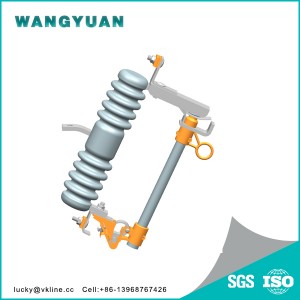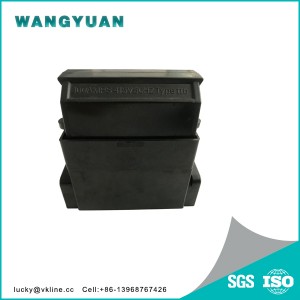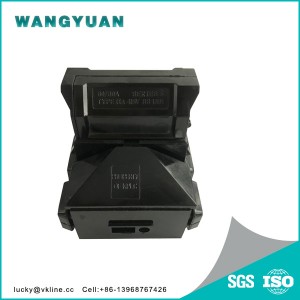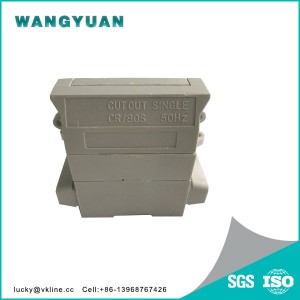Our Products
Drop Out Fuse Cutout 11kv(RW-12)
BASIS DATA
11KV-12KV
| Type | Rated Voltage(kv) | Rated Current(A) | Breaking Current(A) | Impulse Voltage Bil (BIL) | Power-frequency Withstand Voltage | Leakage Distance (MM) | Dimensions(CM) |
| RW-12 | 12 | 100 | 6300 | 110 | 40 | 250 | 40*36*1105 |
| RW-12 | 12 | 100 | 10000 | 110 | 40 | 250 |
The type of cuout fuse:
The drop-type fuse is the most commonly used short-circuit protection switch for the branch lines of 10kV distribution lines and distribution transformers. It has the characteristics of economy, convenient operation, strong adaptability to outdoor environment and so on. It is widely used in the primary side of 10kV distribution lines and distribution transformers for protection and equipment switching and cutting operation.
It is installed on the branch line of 10kV distribution line, which can reduce the scope of power failure. Because of its obvious disconnect point of a high-voltage drop-type fuse, it has the function of isolating switch, which creates a safe working environment for the maintenance line and equipment, and increases the sense of security of maintenance personnel.Installed on the distribution transformer, it can be used as the main protection of the distribution transformer, so it has been popularized in the 10kV distribution line and distribution transformer.
Installation of drop-type fuse:
(1) during installation, the melt should be tightened (so that the melt is about 24.5N tension), otherwise it is easy to cause hair heat.
(2) the fuse shall be firmly and reliably installed on the crossarm (frame) without any shaking or shaking
(3) the molten pipe should have a downward Angle of 25°±2°, so that the molten pipe can fall rapidly by its own weight when the melt is fused.
(4) the fuse shall be installed on the transverse arm (frame) with a vertical distance of no less than 4m from the ground. If installed above the distribution transformer, the horizontal distance between the fuse and the outermost contour boundary of the transformer shall be maintained at a distance of more than 0.5m, in case of other accidents caused by the drop of the fuse.
(5) the length of the fuse shall be adjusted to a moderate level. It is required that the tongue of the duck beak can catch more than two thirds of the length of the contact after closing, so as to avoid the wrong action of self-falling in operation.
(6) the melt used must be the standard products of regular manufacturers, and have a certain mechanical strength, the general requirements of the melt can withstand at least 147N more than the tension.
(7) the 10kV drop-type fuse shall be installed outdoors and the interphase distance shall be greater than 70cm.
Operation of drop-type fuse:
Under normal circumstances, it is not allowed to operate the drop fuse with load, only allow it to operate the no-load equipment (line).However, distribution transformers with rated capacity less than 200kVA and branch lines of 10kV distribution lines in agricultural networks are allowed to operate under load according to the following requirements:
(1) the operation shall be carried out by two persons (one person for supervision and one person for operation), provided that they shall wear qualified insulating gloves, insulating boots and goggles, and operate with qualified insulating rods with the corresponding voltage levels. Operation is prohibited in the weather of lightning or heavy rain.
(2) when pulling the brake operation, it is generally stipulated to pull the intermediate phase first, then the leeward side phase, and finally the windward side phase.This is because the distribution transformer from three – phase operation to two – phase operation, pull the intermediate phase produced by the minimum arc spark, will not cause a short circuit between.The second is to break the leeward side phase, because the intermediate phase has been pulled away, the leeward side phase and the windward side phase distance doubled, even if there is an overvoltage, resulting in a short circuit between the possibility is very small.Finally, when the upwind phase is pulled, only the capacitive current to the ground, the resulting spark has been very slight.
(3) when the switch is closed, the operation sequence is reversed when the switch is pulled. Firstly, the upwind side phase is closed, then the leeward side phase is closed, and finally the intermediate phase is closed.
(4) the operation of the molten tube is a frequent project. If you do not pay attention to it, it will cause the contact burn and lead to bad contact. The contact will be overheated and the spring will be annealed.So, pull, close the melting tube to force moderate, close good, to carefully check the tongue can tightly buckle the tongue tongue two thirds of the length of the above, you can pull the brake bar hook on the mouth of the duck to press down a few times, and then gently try to pull, check whether it is good.Failure to close the switch in place or not close firmly, the static contact on the fuse pressure is insufficient, it is easy to cause contact burn or the melting tube to fall
HOT-SALE PRODUCT
Quality First, Safety Guaranteed












